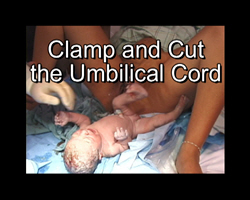|
After delivery of
the baby, the umbilical cord needs to be clamped and cut.
This short, free video
demonstrates this procedure on a live patient.
Clamp and Cut the Umbilical Cord
Runtime 0:27 Min
1.3 MB wmv
Download Now |
|

Clamp and Cut the Umbilical Cord
After the baby is born, leave the umbilical
cord alone until the baby is dried, breathing well and starts to pink
up. During this time, keep the baby more or less level with the
placenta still inside the mother.
Once the baby is
breathing, put two clamps on the umbilical cord, about an inch (3 cm)
from the baby's abdomen. Use scissors to cut between the clamps.
During the transition from
intrauterine to extrauterine life, the umbilical cord will continue,
for a short time, to provide oxygenated blood to the fetus. Once the
baby is breathing, then blood is shunted to its lungs where it
receives much better oxygenated blood than it was getting from the
placenta.
While the cord remains
intact, elevation of the fetus above the level of the placenta (for
example, resting on the mother's abdomen) results in some pooling of
newborn blood within the placenta and can make the baby somewhat
anemic. Holding the baby below the level of the placenta results in
pooling of placental blood within the newborn. This isn't good either,
as the rapid homolysis of the fetal hemoglobin can lead to increased
problems with neonatal jaundice. It is better to keep the baby more or
less level with the placenta until the cord is clamped.
If the baby is not
breathing well after delivery and needs resuscitation, immediately
clamp and cut the cord so you can move the baby to the resuscitation
area.
From OB-GYN 101: Introductory Obstetrics & Gynecology |

